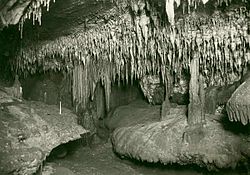Buchan Caves facts for kids
Quick facts for kids Buchan Caves |
|
|---|---|

Fairy Cave
|
|
| Location | East Gippsland, Victoria, Australia |
| Length | 3–4 kilometres (1.9–2.5 mi) |
| Discovery | 1907 (European) |
| Geology | Devonian Limestone |
| Entrances | 6 |
| Show cave opened | Fairy Cave 1907 |
| Show cave length | 400 metres (1,300 ft) |
| Lighting | Electricity |
The Buchan Caves are amazing limestone caves in Victoria, Australia. You can find them near the town of Buchan in East Gippsland. There are two main caves you can visit: the Royal Cave and the Fairy Cave. All together, the caves stretch for about 3 and 4 kilometres (1.9 and 2.5 mi) underground!
The land where the caves are is very special to the Gunaikurnai Nation. They are the traditional owners of this land. Now, they help manage the Buchan Cave Reserve with the government.
The rock that makes up these caves is called limestone. It formed a very long time ago, about 300 to 400 million years ago. Back then, this area was covered by the sea. Many sea creatures like shellfish and coral lived there. When they died, their remains settled on the seabed. Over millions of years, these layers were squashed together. This created the hard limestone rock. The caves themselves were then slowly carved out by water dissolving the limestone.
The Buchan Caves are about 360 kilometres (220 mi) east of Melbourne. It takes about five hours to drive there. You can follow the Princes Highway and then head north from Lakes Entrance.
Contents
Exploring the Buchan Caves
The Buchan Caves are a very popular place to visit in East Gippsland. Many people come to see the beautiful underground formations.
Guided Tours
You can join daily guided tours inside the Royal Cave and the Fairy Cave. These tours help you explore safely.
Royal Cave's Pools
The Royal Cave is famous for its special pools. These pools have edges made of a mineral called calcite. They look like sparkling, natural swimming pools.
Fairy Cave's Formations
The Fairy Cave is known for its amazing stalactites and stalagmites. Stalactites hang down from the cave ceiling. Stalagmites grow up from the cave floor. They can be very big and look like giant icicles or pillars.
Both caves have lights to help you see everything clearly. There are also walkways to make it easy to explore. The temperature inside the caves stays at a comfortable 17 °C (63 °F) all year round. This means it's always a good time to visit!
Things to Do Around the Caves
The Buchan Caves are located inside the Buchan Caves Reserve. There are many things to do above ground too.
Bushwalking and Wildlife
You can go for short or long walks in the bushland around the caves. The nearby Snowy River National Park also has great walking trails. The area is full of trees and wildlife. You might spot over 60 types of birds, including bellbirds and lyrebirds.
Facilities for Visitors
The reserve has places to stay, like campsites and cabins. There are also picnic areas where you can eat. Kids can enjoy the playground. An information centre is available to help you plan your visit.
History of the Caves
The Buchan Caves have a long and interesting history.
Aboriginal History
The Gunaikurnai Nation are the traditional owners of the Buchan Caves area. They have cared for this land and its caves for thousands of years. They are still the custodians of this special place today.
European Discovery
Europeans first made the caves a protected area by accident in 1887. The land was originally set aside for animals to camp. A geologist named Albert Ernest Kitson explored the area. He suggested that the caves should be protected because they were so important geologically.
Opening the Caves
In 1907, a man named Frank Moon explored the Fairy Cave. It was then opened to the public later that same year. The Royal Cave was mapped in 1910. After a special entrance tunnel was dug, it opened to visitors in 1913. The Buchan Caves Reserve was designed and planted mostly in the late 1930s.
The Buchan Caves site is very important. It is listed on the Victorian Heritage Register. This means it is a protected historical place.

